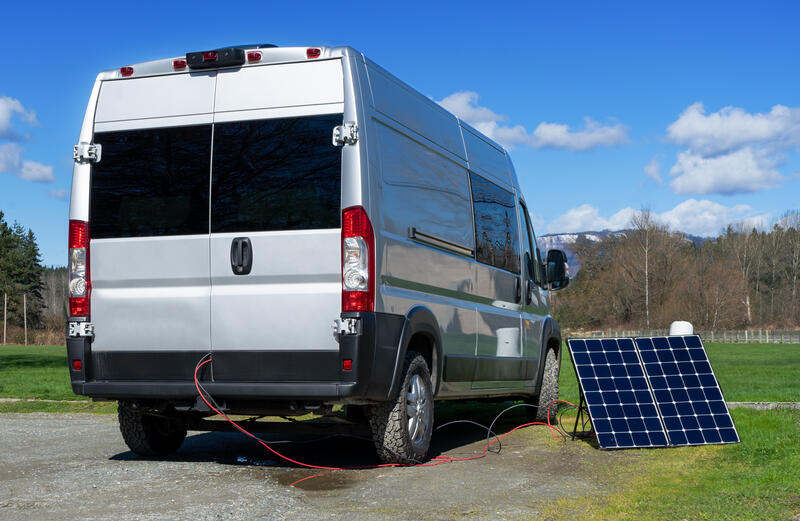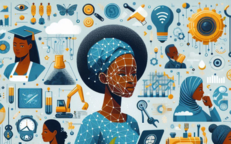Strengthening Africa's Healthcare Through Solar-Powered Mobile Health Clinics

This is the 24th post in a blog series to be published in 2022 by the Secretariat on behalf of the AU High-Level Panel on Emerging Technologies (APET) and the Calestous Juma Executive Dialogues (CJED)
A prosperous Africa based on inclusive growth and sustainable development is envisioned in the African Union Agenda 2063 aspirations. For Africa to realise these aspirations, there is a need to safeguard the citizenry's healthcare and food security. Therefore, sufficient investment should be made to enhance access to high-quality healthcare for every African citizen. Achieving universal healthcare access should be prioritised as a key development urgency. Regrettably, Africa's healthcare systems have barely addressed the capacity of institutional integrity, adequate human skills resources, barely improved financial and technical capacity, and hardly monitored the policy implementation milestones to improve the deployment of the healthcare system.[1]
The COVID-19 pandemic has exposed the weaknesses of Africa's fragile healthcare system. Reports have demonstrated that Africa has a heavy load of chronic diseases and roughly twice as many diseases per person as the rest of the world.[2] In addition, transmissible diseases such as HIV/AIDS and tuberculosis further destabilise the healthcare system. Notably, malaria remains predominant among the causes of death among the African people. Mother and child mortality rates are also four times greater in Africa than in the rest of the world.[3] At the same time, the World Health Organisation has reported that some African countries can barely afford the minimum basic health care of US$34 to US$40 per person per year.[4] This makes Africa's healthcare system fragile and incapacitated to cater for its citizens adequately.[5]
Accomplishing comprehensive and efficient healthcare coverage across the African continent remains a priority for easier access to healthcare services and facilities. Regrettably, most Africans, mostly in rural Africa and hard-to-reach places, which is at least one-sixth of the African population, live more than two hours away from a public hospital and do not have access to healthcare services and facilities. Additionally, only one in eight lives more than one hour away from the closest healthcare facility. Therefore, due to the distance barrier to accessing healthcare facilities, many diseases and illnesses disproportionately affect certain African populations. This is due to disparities in healthcare access and social determinants of healthcare access. Thus, access to healthcare facilities and services needs to be improved in Africa. This can enable African residing in rural and hard-to-reach places to have access to healthcare facilities and services effectively and sustainably. Thus, considerations toward adopting mobile health technology should be made to enhance access to healthcare services.
The African Union High-Level Panel on Emerging Technologies (APET) believes that innovative healthcare delivery strategies such as Mobile Health Clinics (MHCs) can potentially reduce healthcare disparities for the Africa’s most vulnerable populations. The MHCs significantly enhance emergency healthcare, conducting preventative health screenings and managing chronic illnesses. APET believes that MHCs can also provide specialised, high-impact, and cost-effective healthcare services. In addition, the MHCs can be localised to address the local community's changing healthcare needs. This can be accomplished by opening their doors directly into communities and leveraging and strengthening the existing community resources.[6] Thus, mobile clinics can provide adaptable and practical choices for treating vulnerable and isolated communities that cannot access healthcare facilities easily.
However, the limiteded access to electric power is the impeding factor for applying MHCs in isolated and hard-to-reach places. This limited electricity access impedes storage, lighting, and clinical operations. Consequently, healthcare workers fail to safely deliver their healthcare services, such as emergency obstetric care and other medical procedures. In addition, the capability to refrigerate vaccines, which are saving countless millions of lives annually, depends on having access to dependable electricity. APET notes that electricity is also needed to prevent and treat non-communicable illnesses through vaccinations and temperature-specific medicines, and the demand for cold storage space is needed.
Furthermore, APET realises that the underdevelopment of the energy capacity with both power generation and distribution is impeding the electricity supply and barely keeping up with the demand. Some African countries are experiencing power outages 50% of the time.[7] As a result, the prevalent incapacity to access electricity from the national grid compels many clinics to rely on diesel-powered generators.[8] Unfortunately, these generators remain unreliable, expensive to operate, and environmentally unfriendly. Additionally, the backup generators cannot counteract the sudden blackouts that potentially damage the delicate medical machinery and disrupt medical procedures, endangering the patients' lives.
Thus, by providing adequate, reliable, renewable electricity, mobile health facilities can operate over extended hours. This can allow medical practitioners to consult with more patients daily and offer emergency medical services around the clock. Currently, mobile health clinics cannot operate after hours because of limited access to essential medical tools and lighting sources. These clinics significantly rely on paraffin lamps, candles, and hand-held torches to address these challenges.[9] Unfortunately, such light sources affording the facilities provide poor light quality, emitting hazardous and interfering gases and may pose a significant fire risk.
MHCs are designed to provide primary and community-level services in remote places with low energy consumption and limited connectivity to the electricity grid. Since the grid extension to these places is difficult to construct and maintain because of costs, APET proposes adopting off-grid MHCs that can be powered by renewable energy such as solar and wind energy.[10] This offers cost-effective options for powering remote off-grid healthcare facilities. However, the challenge with the solar system is power storage. Therefore, APET is recommending using next generation batteries such as lithium batteries to address the electricity storage challenge.[11]
APET, through the reports, namely, "Micro-Grids – Empowering Communities and Enabling Transformation in Africa"[12] and an upcoming APET report, namely, "Let There Be Light: Next-Generation Batteries for Africa's Energy Needs" to be published in 2022, have challenged African countries to consider the great potential generating off-grid renewable energy through solar, wind, and even hydropower. Worth noting is that the costs essential for installing these sustainable power sources are continually dropping. For example, solar panel prices have declined by approximately 80% over the 10 years.[13] APET recognises that renewable energy can offer mobile clinics economical, cost-effective, dependable, and autonomous sources of electricity that can substantially expand and enhance healthcare access and delivery where electric power remains challenging — especially in remote rural areas.[14]
APET observes that small photovoltaic (PV) solar power systems are currently being utilised across Africa.[15] These solar systems enable healthcare workers to deliver care and diagnoses, charge cell phones for communication and safeguard vaccines and other medications in portable cooler units.[16] On the other hand, large PV solar arrays are utilised to provide electricity to a range of critical devices such as lights, water pumps, cell phones, and refrigerators. They are also powering laboratory equipment and a host of essential medical devices.
Despite this substantive potential to address the healthcare system, APET observes the limited application of renewable energy in African mobile healthcare facilities. These facilities remain underfunded and can barely afford the installation costs for renewable energy.[17] To address this challenge, APET challenges African countries to pursue public-private initiatives. This is because multinational companies operating in Africa can support and fund the essentials of primary healthcare in local communities, such as electricity.[18]
There are currently funded projects on big hospitals and clinics implementing renewable energy, such as solar power, to power their various activities. For example, Enel Green Power (EGP) works with St. Luke Hospital in Wolisso, Ethiopia, located about 110 kilometres southwest of Addis Ababa. Wolisso has more than 60,000 people, and the hospital serves a patient base of over a million people.[19] St. Luke is suffering frequent power outages despite its significance to the community. Consequently, this compels the hospital to resort to diesel generators to safeguard a consistent power supply. However, EGP has designed and built an innovative solar hybrid system for St. Luke hospital to power its operations during power outages. The solar power panel comprises a photovoltaic plant and lithium batteries. As a result, the hospital can sustainably deliver over 320 kWh of electricity.[20] Interestingly, the renewable energy plant can also manage the flow of energy in real-time to ensure a continuous power supply. This ensures that the hospital can provide sustainable healthcare to approximately 79,000 outpatient visits, 15,000 hospitalisations, and 4,000 births annually.[21]
Worth noting is that the incorporation of solar power has proven cost-effective and efficient. It provides savings―money that the hospital can reinvest into the community's healthcare services. Therefore, this demonstrates the powerful nexus between energy and health care in Africa by promoting access to electricity as a key enabler of access to healthcare. However, this addresses a big hospital; APET believes this can also be translated into mobile healthcare clinics for remote places. To this end, some African countries have adopted the utilisation of renewable energy to power their mobile clinics.[22]
For example, Samsung and South Africa have established and launched mobile Solar Powered Health Centres in remote rural areas.[23] These mobile clinics are intended to eradicate the economic and geographic barriers that impede people across Africa from accessing quality medical treatment. Notably, South Africa has approximately 20% of the population having access to private medical schemes. This leaves the public healthcare sector battling to serve the remaining 80% of the population.[24] Thus, South Africa, in partnership with Samsung, has been installing Solar Powered Health Centres from 2015 to reach one (1) million people.[25] These mobile healthcare centres are part of Samsung's broader Corporate Social Responsibility goal to positively impact the lives of five million people in Africa from 2015.[26]
Essentially, the Solar Powered Health Centre is a seven-metre truck comprising a fully equipped ear, eye, and blood clinic and dental surgery.[27] The facility focuses on screening people to determine medical conditions such as diabetes, high blood pressure, tooth decay, and cataracts. In addition, as part of capacity building, the facility also focuses on educating communities about health issues and persuading people to undertake medical tests as preventative measures. For example, the eye and blood clinic is situated at the front of the truck. This unit consists of a reclining chair for the patients, a sink, and a mirror. This also has high technology equipment, including a blood analyser and a spectacle repair kit. It also has a "Reichert PT100 portable NCT", a non-contact tonometry test to determine the pressure inside the eye.
The X-ray unit constitutes an air motor, mobile suction unit, water distiller, and needle incinerator. Furthermore, this mobile clinic has a station for testing for HIV, malaria, and other medical conditions. A dental clinic is also equipped with the usual chair and overhead light.
APET appreciates and encourages the private sector participation in providing healthcare solutions for the public sector. Notably, the Department of Health in South Africa, pharmaceutical companies, and Samsung are participative in this project.[28] Other partners include medical universities, and organisations that are involved in health care such as World Vision, and Doctors without Borders. In June 2013, Samsung incorporated a mother-and-child clinic with the capacity for 4D ultrasound scans and delivering babies.[29] Furthermore, APET calls for the incorporation of power sources that will be reliable as such projects are expanded throughout the African continent.
In 2007, the partners of the Department of Health in Malawi initiated the Abwenzi Pa Za Umoyo (APZU) in the rural Neno district using solar energy.[30] APET observes that the value of this mobile clinic cannot be paralleled because the initiative was established to provide comprehensive, community-based care to a catchment area of approximately 125,000 people.[31] In October 2013, the mobile clinic was executed to expand and enhance access to quality healthcare services to marginalised, remote, and underprivileged populations in Malawi's rural Neno district.[32] Notably, the clinic has accomplished the overarching strategic intentions of PIH Malawi of providing healthcare accompanied by socio-economic support. For example, the clinic provides antenatal services for pregnant women, immunisation, growth monitoring for children under 5, family planning for women of childbearing age, HIV testing and counselling, rapid malaria test, and rapid typhoid test.[33] Furthermore, medication prescriptions and distributions are also part of the mobile clinic process.
However, one of the main challenges encountered, especially during the deployment of COVID-19 vaccines in rural Africa, was the limited capacity to refrigerate the vaccines. Thus, cold storage of medicines and vaccines remain difficult, irrespective of the weather conditions in some African countries. To address this challenge, the African Medical and Research Foundation (AMREF) utilised solar-powered mobile clinics to distribute COVID-19 vaccines in Kenya to enhance their immunisation efforts.[34] APET recognises that the solar-powered clinics have enabled the organisation and administering of COVID-19 vaccines in areas with limited or no electricity.
In addition, Zimbabwe has an erratic electricity power failure system, which negatively impacts healthcare delivery in rural areas. Zimbabwe's rural villages, such as the Goromonzi district, approximately 40 kilometres northeast of Harare, have created mobile clinics in the form of a car that has been transformed into a mobile health clinic.[35] This mobile health clinic comprises a wind turbine and solar panels to power a freezer where vaccinations may be stored.[36] Consequently, the clinic has managed to provide vaccines to previously disadvantaged communities around the Goromozi district.
Finally, to accomplish the AU's Agenda 2063 and United Nation's Sustainable Developmental Goals (SDGs), APET is challenging African countries to prioritise expanding healthcare access to their citizens by deploying solar-powered mobile health clinics. This will enable all Africans to access healthcare facilities irrespective of geographical location. However, investments in renewable energy as an alternative source should be made to enable the deployment of these mobile clinics. APET is challenging innovators and policymakers to enhance mobile clinics with renewable energy to improve the healthcare of the African continent. Thus, investments and policy implementation toward enhancing mobile healthcare clinics should be pursued and expanded. This will strengthen healthcare delivery in a cost-effective manner, especially in the most remote and hard-to-reach places in Africa.
Featured Bloggers – APET Secretariat
Justina Dugbazah
Barbara Glover
Bhekani Mbuli
Chifundo Kungade
Nhlawulo Shikwambane
[1] https://www.dovepress.com/identifying-key-challenges-facing-healthcare-systems-in-africa-and-pot-peer-reviewed-fulltext-article-IJGM.
[2] de-Graft Aikins, A., Unwin, N., Agyemang, C. et al. Tackling Africa's chronic disease burden: from the local to the global. Global Health 6, 5 (2010). https://doi.org/10.1186/1744-8603-6-5.
[3] https://www.mckinsey.com/featured-insights/middle-east-and-africa/acting-now-to-strengthen-africas-health-systems.
[4] Marge Berer (2010) Who has responsibility for health in a privatised health system?, Reproductive Health Matters, 18:36, 4-12, DOI: 10.1016/S0968-8080(10)36547-5.
[5] https://www.ifc.org/wps/wcm/connect/news_ext_content/ifc_external_corporate_site/news+and+events/healthafricafeature.
[6] https://equityhealthj.biomedcentral.com/articles/10.1186/s12939-017-0671-2.
[7] https://qz.com/africa/1431213/africas-electricity-shortages-have-health-and-economic-costs/.
[8] https://www.crownagents.com/blog-post/divesting-from-diesel-powered-generators-in-sub-saharan-africas-health-sector-the-case-is-clear/.
[9] Yu, S., Hill, C., Ricks, M. L., Bennet, J., & Oriol, N. E. (2017). The scope and impact of mobile health clinics in the United States: a literature review. International journal for equity in health, 16(1), 178. https://doi.org/10.1186/s12939-017-0671-2.
[10] https://www.un.org/africarenewal/magazine/january-2021/push-renewables-how-africa-building-different-energy-pathway.
[11] https://www.seforall.org/system/files/2022-03/phc-impact-factsheet-006.pdf.
[12] https://www.nepad.org/publication/micro-grids-empowering-communities-and-enabling-transformation-africa.
[13] https://www.nrel.gov/news/features/2020/declining-renewable-costs-drive-focus-on-energy-storage.html.
[14] https://www.seforall.org/news/editors-pick-energizing-africas-health-care-how-electricity-helps-make-people-better.
[15] https://www.weforum.org/agenda/2022/03/solar-energy-security-farm-africa/.
[16] https://apps.who.int/iris/bitstream/handle/10665/254715/WHO-IVB-17.01-eng.pdf;sequence=1.
[17] https://www.nationalgeographic.com/science/article/partner-content-energizing-africas-health-care.
[18] Oleribe, O. O., Momoh, J., Uzochukwu, B. S., Mbofana, F., Adebiyi, A., Barbera, T., Williams, R., & Taylor-Robinson, S. D. (2019). Identifying Key Challenges Facing Healthcare Systems In Africa And Potential Solutions. International journal of general medicine, 12, 395–403. https://doi.org/10.2147/IJGM.S223882.
[19] https://www.enelgreenpower.com/stories/articles/2019/03/photovoltaic-battery-hybrid-system-st-luke-hostpital-ethiopia.
[20] https://pmivectorlink.org/2022/05/11/solar-powered-systems-reliable-electricity-for-cooling-systems-and-data-collection/.
[21] https://www.enelgreenpower.com/stories/articles/2019/03/photovoltaic-battery-hybrid-system-st-luke-hostpital-ethiopia.
[22] Adair-Rohani, H., Zukor, K., Bonjour, S., Wilburn, S., Kuesel, A. C., Hebert, R., & Fletcher, E. R. (2013). Limited electricity access in health facilities of sub-Saharan Africa: a systematic review of data on electricity access, sources, and reliability. Global health, science and practice, 1(2), 249–261. https://doi.org/10.9745/GHSP-D-13-00037.
[23] https://www.itweb.co.za/content/3mYZRXM9ded7OgA8.
[24] https://www.wits.ac.za/news/latest-news/opinion/2021/2021-07/healthcare-in-south-africa-how-inequity-is-contributing-to-inefficiency.html.
[25] https://brandsouthafrica.com/solar-powered-clinic-130715.
[26] https://memeburn.com/2013/03/samsung-to-roll-out-mobile-health-centres-across-africa/.
[27] https://www.theguardian.com/global-development/2013/mar/15/africa-solar-health-cape-town.
[28] https://healthmarketinnovations.org/program/samsung-solar-powered-health-centre.
[29] https://www.msf.org.za/about-us.
[30] Wachter K, Talbot JR, Weintraub R. Partners In Health in Neno District, Malawi. Harvard Business Publishing. 2013.
[31] Geoffroy, E., Harries, A. D., Bissell, K., Schell, E., Bvumbwe, A., Tayler-Smith, K., & Kizito, W. (2014). Bringing care to the community: expanding access to health care in rural Malawi through mobile health clinics. Public health action, 4(4), 252–258. https://doi.org/10.5588/pha.14.0064.
[32] https://healthmarketinnovations.org/program/mobile-clinic-malawi-pih-and-moh.
[33] https://apps.who.int/iris/bitstream/handle/10665/250796/9789241549912-eng.pdf.
[34] https://www.africanews.com/2022/07/11/solar-powered-health-truck-delivers-covid-19-vaccines-to-remote-areas//.
[35] https://www.gavi.org/vaccineswork/vaccine-taxi-going-mobile-zimbabwe.
[36] https://www.timeslive.co.za/sunday-times-daily/africa/2021-07-12-zim-mobile-clinic-freezes-and-stores-vaccines-using-wind-and-solar-power/.


